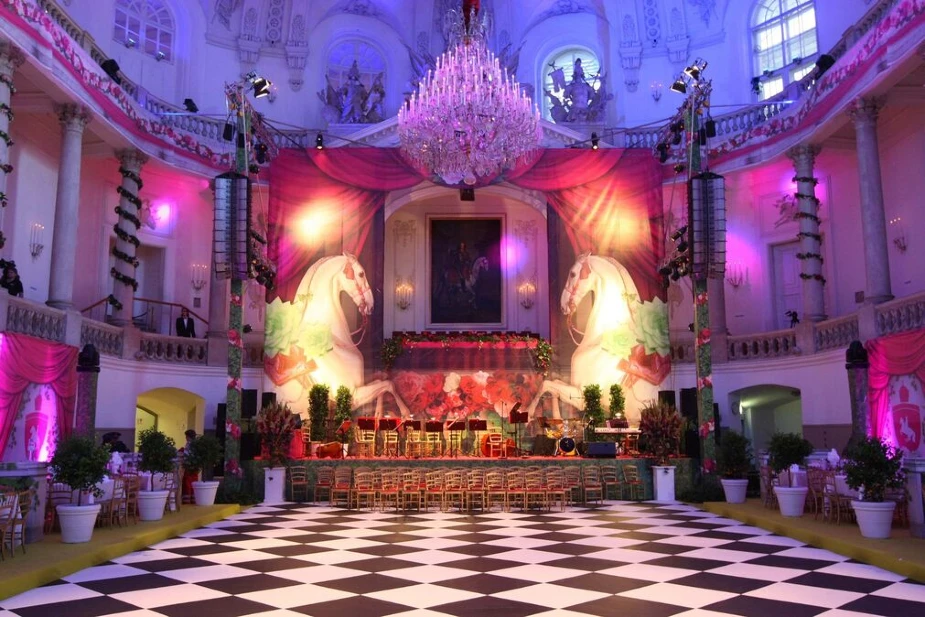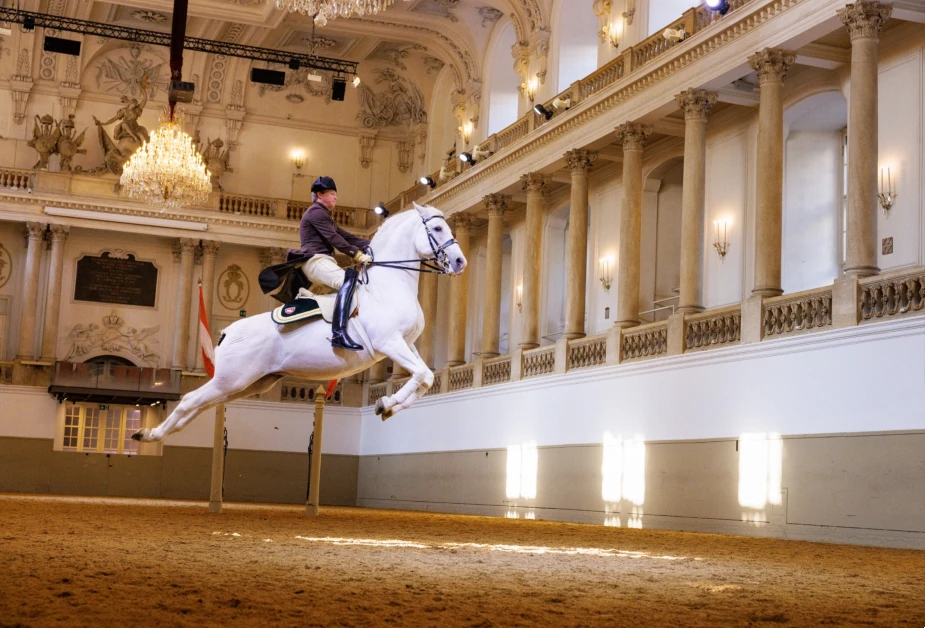The Spanish Riding School is a part of the Hofburg Imperial Palace.
In the years following the end of the Hapsburg Empire, many institutions became independent attractions.
At the Spanish Riding School, you will get an idea of classical dressage and the different halls that house the different activities of the Lipizzaner horses.
Training and Performance
Equestrian Dressage requires an intensive program that prepares the horses for a long career with refined and perfected actions by the riders.
Some popular moves for the Lipizzan stallions are the levade, the capriole, the courbette, the croupade, and the mezair. The mezair is now discontinued.
The capriole is an upward leap made without going forward and with a backward kick of the hind legs while the horse is in mid-air.
Another performance highlight of the show will be the levade, in which the stallion puts its entire weight on its hind legs and raises its front legs to 45 degrees.
The courbette is where the horse raises its forehand off the ground, tucks up its forelegs evenly, and then jumps forward in a series of ‘hops’.
The morning training sessions on weekdays often showcase some of these above-the-ground movements.
A combination of relaxation and strengthening of the muscles is accommodated at the Summer Riding Hall, where the horses can wind down before their vacations at Piber.
This standardized progressive training builds Lipizzan’s natural athletic ability and willingness to perform.
Ideally, the rider smoothly communicates the instructions with minimal aid and should remain relaxed.
The development of the art went hand-in-hand with the popularity of indoor riding by the royalty and nobility during the Renaissance.
Although the discipline has roots in Ancient Greece, the European Kingdoms put effort into acquiring and breeding horses, such as the Lipizzan Stallions.
‘Horse Ballet’ defines how dressage includes lateral work, piaffe, passage, and other airs above the ground movements.
Baroque Winter Riding Hall – Winterreitschule

The Ballet of the White Stallions is the season’s most notable performance in the Winter Riding Hall.
The foals start training at the age of four. They grow up in the Haute Ecole traditions preserved under UNESCO’s list of intangible cultural heritage.
There are three ways to enjoy the Riding Hall at the Spanish Riding School. The most typical is the everyday drills that provide an informal opportunity to view the Lipizzan.
Second, you can enjoy the decorum and performance of the Equestrian Dressage during the shows. The horses train for the show all year!
During the architectural tour, you get to learn about the history of the structure and the traditions.
The tour is suitable for people with children younger than three years, as they are not admitted to the shows for safety reasons.
These School Stallions perform the School Quadrille and on the Long Rein to the sound of classical Viennese music inside the Spanish Riding School.
Summer Riding Hall – Sommerreitschule
The Lipizzan horses leave for their summer vacation between July and mid-August to Piber, the third branch of the Spanish Riding School.
The Summer Riding Hall features the longest oval walking track for these special horses to start training them in their younger years.
‘Piber Meets Vienna’ is a unique opportunity to see the young foals after being transferred to the Spanish Riding School.
The baby foals accompany the mares in one of their first showings to the public during the winter in another unique opportunity to see the horses.
Stallburg
The Lipizzaner stallions still use the Stallburg Imperial Stables constructed in the 1560s.
A large Renaissance stable complex that is only accessible with tours of the Spanish Riding School.
One of Vienna’s few surviving Renaissance buildings, you can see the contrast with the Baroque and Rococo townhouses on its sides.
Initially keeping the personal horses of the court, the Lipizzaners replaced them with their growing popularity.
This building is not inside the Spanish Riding School. However, it is surprising to see an active stable in the middle of Vienna.
The upper stories were used to house guests of the royal estate alongside the imperial art collection.
The Stallburg soon became a formal gallery as different emperors accumulated their own art collections.
Featured Image: Srs.at




